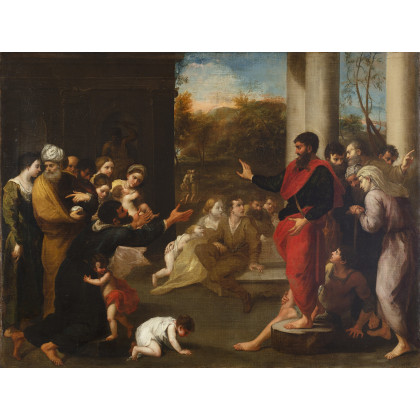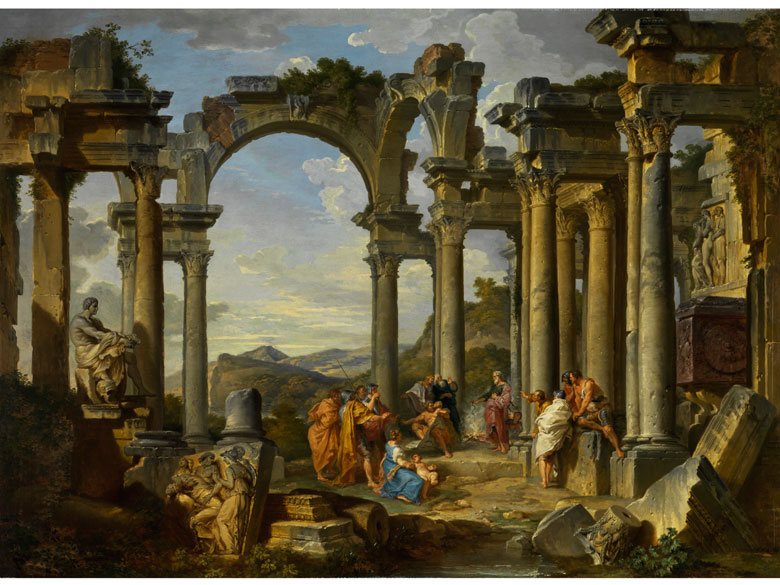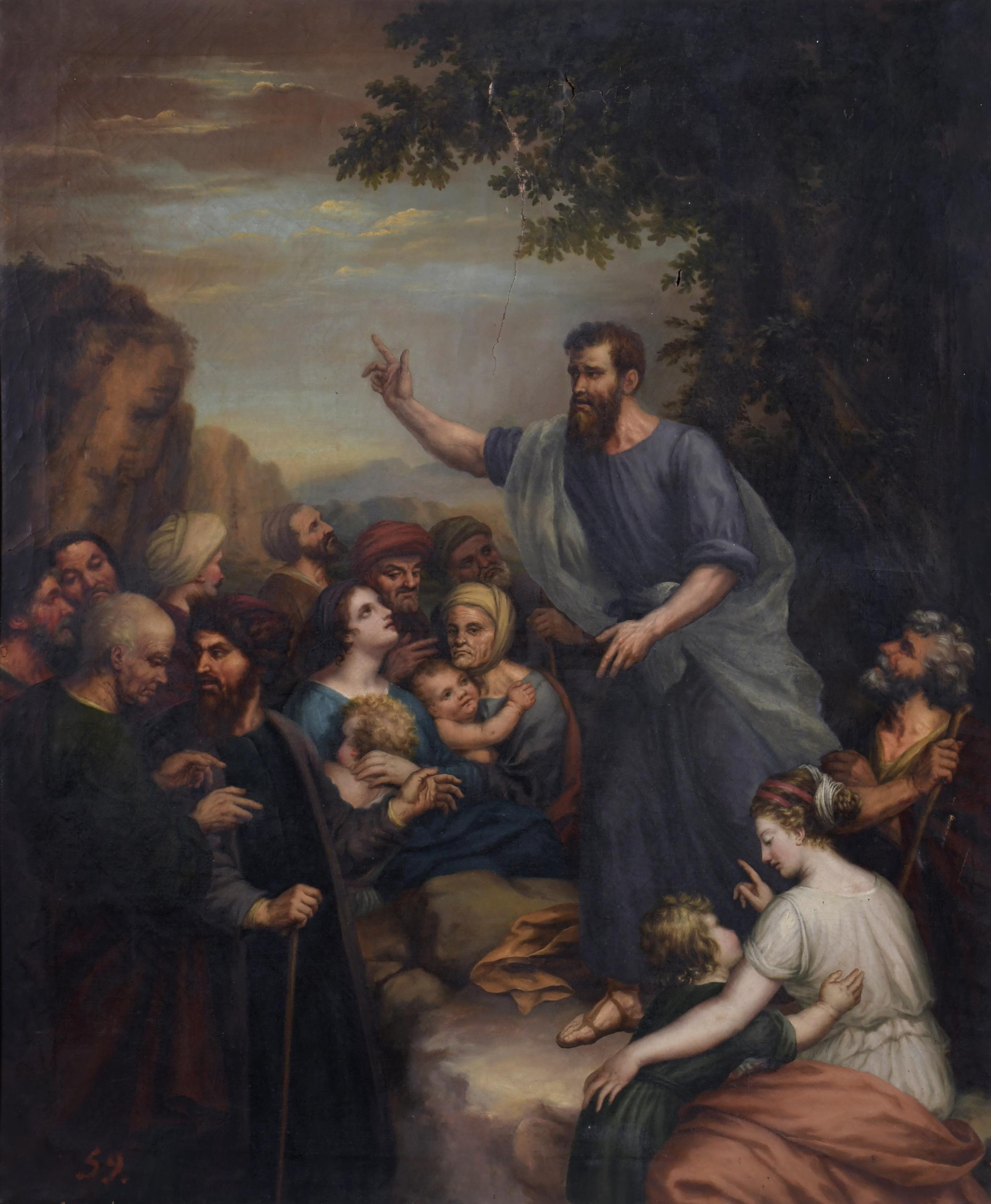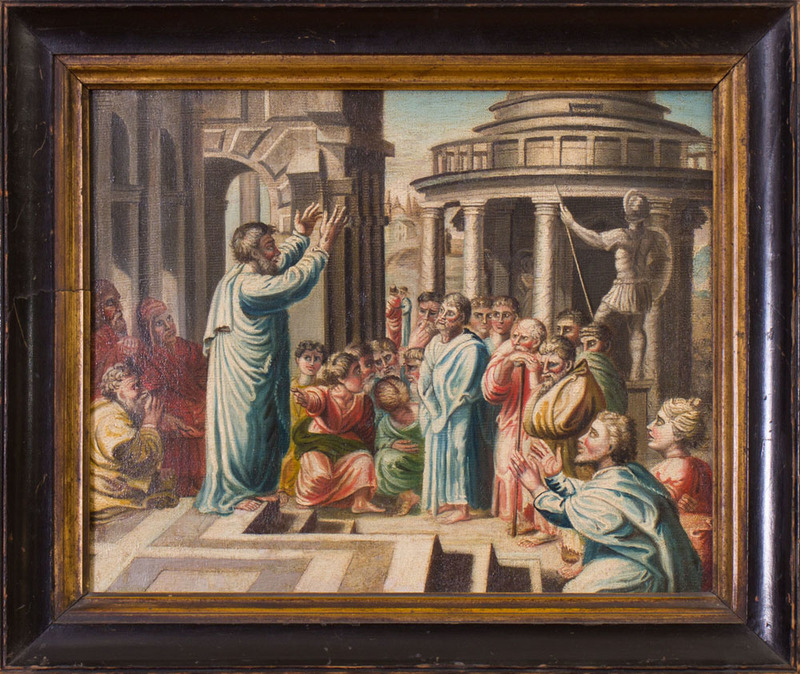SAINT PAUL PREACHING, in an initial P on the verso of a half-leaf from a Bible, ILLUMINATED MANUSCRIPT ON VELLUM [Romagna, c.1270] 460 x 163mm. St Paul in three-quarter length, gesturing to indicate speech, in an attenuated letter P with knotted and cusped staves terminating in acanthus leaves on a blue ground; whole leaf of two columns of 41 lines written in brown ink in a gothic bookhand; rubric in large red display script, letters of first two lines of text and one-line initials touched red, two-line initials of red, four-line illuminated initial (some fading to ink and pink, small smudge to red letters beside initial and bottom of Paul's robe, small pen erosion affecting 2 letters only at bottom of text). Framed. The initial opens the First Epistle of Paul to Timothy Paulus christi ihesu secundum imperium dei salvatoris , and is on the outer half of a leaf from a large-format Bible. This form originally evolved for the opulent presentation volumes that were at the heart of a church or monastery library but, by the end of the 12th century, monumental Bibles were being made for reading aloud to the monks during meals: they have consequently become known as 'refectory Bibles'. The revival of demand for lectern Bibles in the 15th century may have been the stimulus that encouraged an opportunistic Gutenberg to undertake mechanical mass-production: C. de Hamel, The Book. A History of the Bible , 2001, pp.64-81 and 190-196. By the time that this leaf with St Paul was written the prevalent type of Bible -- which was being made in large numbers -- was the small-format single-volume Bible that was developed in Paris and set the pattern that is followed to this day. These portable Bibles mostly conformed to a standard arrangement. The Bible from which this leaf came served a different function and followed an older organisation: the tituli on the recto of the leaf show that Timothy's Epistle was divided into thirty chapters rather than the six that has been standard since the 13th century. The restrained palette and the slender figures clothed in softly falling drapery are typical of Bolognese illumination known as the Academic or First Style. The broad-browed figures with their long-fingered loose gestures and deep-set eyes are analagous to those of a Gradual from the first series of choirbooks made for the Cathedral of Imola in the 1270s (now Museo Diocesano, Ms corale III): Corali miniati di Faenza, Bagnacavallo e Cotignola , ed. F. Lollini, 2000, tav.X. The present leaf, like that Gradual, can be attributed to a follower of the Master of Bagnocavallo, the illuminator of a series of choirbooks which probably came from the Franciscan convent in Bagnocavallo and are now in the Biblioteca Comunale Taroni there. The Master also provided some of the illumination for another refectory Bible, in four volumes, and datable around 1270. (Cesena, Biblioteca Malatestiana, Ms D.XXI.1). PROVENANCE: Purchased from Laurence Witten 1979. Voelkle and Wieck, no 56. RELATED LEAVES: Les Enluminures , 16, no 16; Milan, Longari collection; formerly Milan, Mondari collection.
SAINT PAUL PREACHING, in an initial P on the verso of a half-leaf from a Bible, ILLUMINATED MANUSCRIPT ON VELLUM [Romagna, c.1270] 460 x 163mm. St Paul in three-quarter length, gesturing to indicate speech, in an attenuated letter P with knotted and cusped staves terminating in acanthus leaves on a blue ground; whole leaf of two columns of 41 lines written in brown ink in a gothic bookhand; rubric in large red display script, letters of first two lines of text and one-line initials touched red, two-line initials of red, four-line illuminated initial (some fading to ink and pink, small smudge to red letters beside initial and bottom of Paul's robe, small pen erosion affecting 2 letters only at bottom of text). Framed. The initial opens the First Epistle of Paul to Timothy Paulus christi ihesu secundum imperium dei salvatoris , and is on the outer half of a leaf from a large-format Bible. This form originally evolved for the opulent presentation volumes that were at the heart of a church or monastery library but, by the end of the 12th century, monumental Bibles were being made for reading aloud to the monks during meals: they have consequently become known as 'refectory Bibles'. The revival of demand for lectern Bibles in the 15th century may have been the stimulus that encouraged an opportunistic Gutenberg to undertake mechanical mass-production: C. de Hamel, The Book. A History of the Bible , 2001, pp.64-81 and 190-196. By the time that this leaf with St Paul was written the prevalent type of Bible -- which was being made in large numbers -- was the small-format single-volume Bible that was developed in Paris and set the pattern that is followed to this day. These portable Bibles mostly conformed to a standard arrangement. The Bible from which this leaf came served a different function and followed an older organisation: the tituli on the recto of the leaf show that Timothy's Epistle was divided into thirty chapters rather than the six that has been standard since the 13th century. The restrained palette and the slender figures clothed in softly falling drapery are typical of Bolognese illumination known as the Academic or First Style. The broad-browed figures with their long-fingered loose gestures and deep-set eyes are analagous to those of a Gradual from the first series of choirbooks made for the Cathedral of Imola in the 1270s (now Museo Diocesano, Ms corale III): Corali miniati di Faenza, Bagnacavallo e Cotignola , ed. F. Lollini, 2000, tav.X. The present leaf, like that Gradual, can be attributed to a follower of the Master of Bagnocavallo, the illuminator of a series of choirbooks which probably came from the Franciscan convent in Bagnocavallo and are now in the Biblioteca Comunale Taroni there. The Master also provided some of the illumination for another refectory Bible, in four volumes, and datable around 1270. (Cesena, Biblioteca Malatestiana, Ms D.XXI.1). PROVENANCE: Purchased from Laurence Witten 1979. Voelkle and Wieck, no 56. RELATED LEAVES: Les Enluminures , 16, no 16; Milan, Longari collection; formerly Milan, Mondari collection.





.jpg)








Try LotSearch and its premium features for 7 days - without any costs!
Be notified automatically about new items in upcoming auctions.
Create an alert